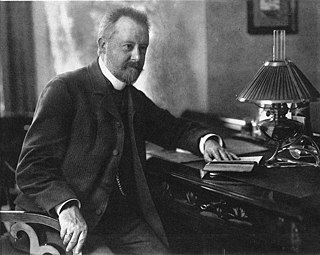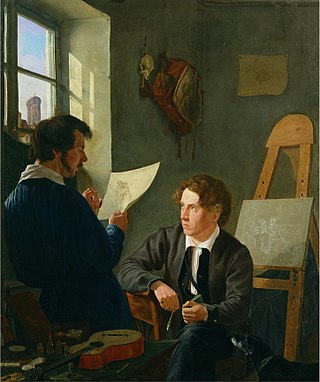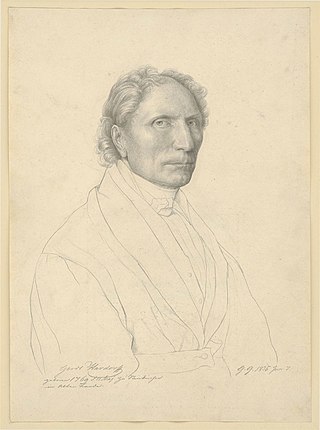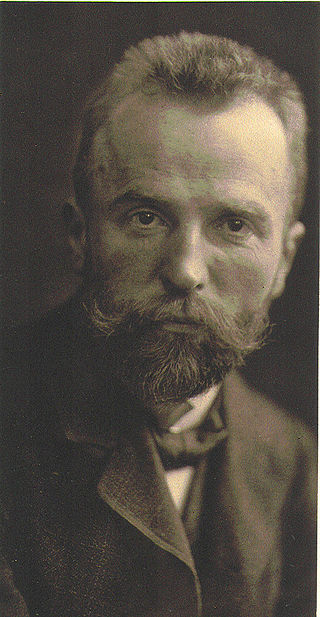This article relies largely or entirely on a single source .(March 2021) |

Heinrich Joachim Herterich (May/June 1772, Hamburg - 20 March 1852, Hamburg) was a German lithographer, painter and etcher.
This article relies largely or entirely on a single source .(March 2021) |

Heinrich Joachim Herterich (May/June 1772, Hamburg - 20 March 1852, Hamburg) was a German lithographer, painter and etcher.
He studied with his father, Johann Andreas Herterich (1725–1794), who was originally from Bayreuth. In 1804, he made a study trip to Paris. Initially, he worked as a portrait painter, in a style influenced by Claude Lorrain.
He learned lithography in 1817, from Johann Michael Mettenleiter , in Munich. The following year, he returned to Hamburg with a team of specialists, in a joint venture with Johannes Michael Speckter, to establish the first lithography firm in Northern Germany. The company proved to be very successful, although Herterich personally continued to prefer painting to lithography. In 1825, he helped to set up a "Lithographic Institute" in Berlin, modelled after the one in Munich.
He remained closely connected to the Speckter family until his death; serving as a teacher for his partner's sons, Erwin and Otto.
He was interred at the Ohlsdorf Cemetery, adjacent to the plot belonging to the Speckters.
![]() Media related to Heinrich Joachim Herterich at Wikimedia Commons
Media related to Heinrich Joachim Herterich at Wikimedia Commons

Philipp Otto Runge was a German artist, draftsman, painter, and color theorist. Runge and Caspar David Friedrich are often regarded as the leading painters of the German Romantic movement. He is frequently compared with William Blake by art historians, although Runge's short ten-year career is not easy to equate to Blake's career. By all accounts he had a brilliant mind and was well versed in the literature and philosophy of his time. He was a prolific letter writer and maintained correspondences and friendships with contemporaries such as Carl Ludwig Heinrich Berger, Caspar David Friedrich, Johann Wolfgang von Goethe, Friedrich Wilhelm Joseph Schelling, Henrik Steffens, and Ludwig Tieck. His paintings are often laden symbolism and allegories. For eight years he planned and refined his seminal project, Tageszeiten, four monumental paintings 50 square meters each, which in turn were only part of a larger collaborative Gesamtkunstwerk that was to include poetry, music, and architecture, but remained unrealized at the time of his death. With it he aspired to abandon the traditional iconography of Christianity in European art and find a new expression for spiritual values through symbolism in landscapes. One historian stated "In Runge's painting we are clearly dealing with the attempt to present contemporary philosophy in art." He wrote an influential volume on color theory in 1808, Sphere of Colors, that was published the same year he died.

The Jauch family of Germany is a Hanseatic family which can be traced back till the Late Middle Ages. At the end of the 17th century the family showed up in the Free Imperial and Hanseatic City of Hamburg. The members of the family acted as long-distance merchants. They became hereditary grand burghers of Hamburg and were Lords of Wellingsbüttel Manor – nowadays a quarter of Hamburg.

Joachim Heinrich Campe was a German writer, linguist, educator and publisher. He was a major representative of philanthropinism and the German Enlightenment.

The Gottfried Wilhelm Leibniz Prize, or Leibniz Prize, is awarded by the German Research Foundation to "exceptional scientists and academics for their outstanding achievements in the field of research". Since 1986, up to ten prizes have been awarded annually to individuals or research groups working at a research institution in Germany or at a German research institution abroad. It is considered the most important research award in Germany.

Carl Friedrich von Rumohr was a German art historian, writer, draughtsman and painter, agricultural historian, connoisseur of and writer about the culinary arts, art collector and patron of artists.

Gustav Falke was a German writer.

Adolf Schrödter or Adolph Schroedter was a German painter and graphic artist; associated with the Düsseldorf school of painting. He is considered to be one of the pioneers of German comics.

Friedrich Carl Gröger was a north-German portrait painter and lithographer. One of the most respected portraitists of his time in northern Germany, his works are to be found in several museums, including the Hamburger Kunsthalle, as well as in north German, Holstein and Danish private collections.

Wilhelm Johann Karl Zahn was a German architect, painter, art critic and design researcher particularly of Roman interior designs found in the ruins of Pompeii. Wilhelm was born as the fourth of five children of painter Bernhard Zahn, and his wife, Christiane, née Weis according to church records. He attended high schools in Bückeburg and Rinteln where he received a universal education. It was in Rinteln where Zahn studied the classics under a Professor Stein who Zahn remembered with particular affection.

Erwin Speckter was a German painter, often associated with the Nazarene movement.

Hermann Kauffmann also Herrmann Kauffmann was a German painter and lithographer, and one of the main representatives of the Hamburger Schule.

Johann Georg Haeselich was a German genre painter and lithographer.
Friedrich Wilhelm Birnstiel was an 18th-century German music publisher known for publishing two volumes of four-part chorales by Johann Sebastian Bach in the 1760s.
Rudolf Heinrich was a German stage designer.

Johannes Michael Speckter was a German lithographer and graphics collector.

Otto Speckter was a German etcher and illustrator.

Gerdt Hardorff was a German painter, art collector and drawing teacher. He is sometimes referred to as The Elder to distinguish him from his son, Gerdt, who also became a painter.

Johann Caspar Herterich, sometimes known as Hans was a German history and genre painter. He was also a popular Professor at the Academy of Fine Arts, Munich.

Karl Wilhelm Arthur Illies was a German painter and graphic artist.